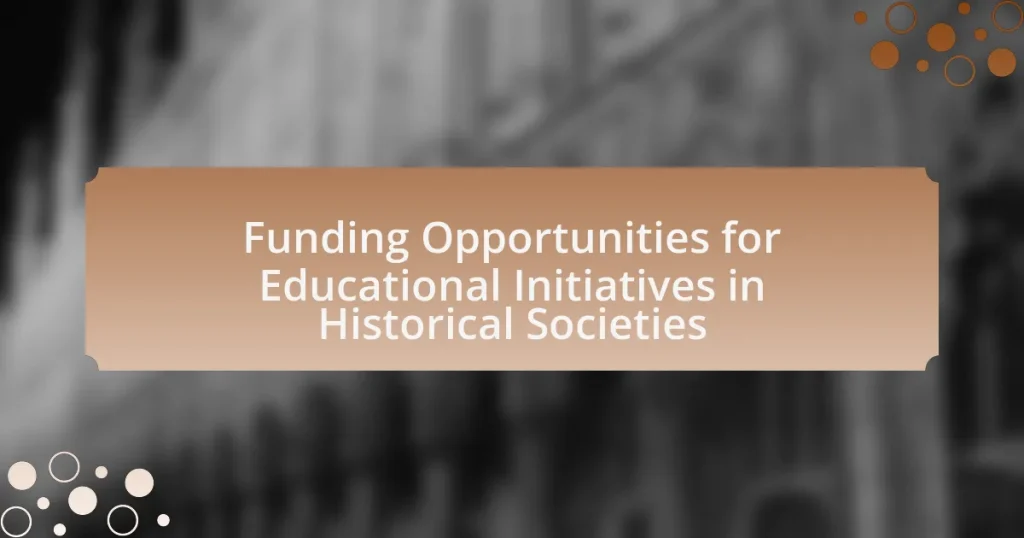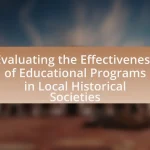Funding opportunities for educational initiatives in historical societies are critical for promoting historical understanding and preserving cultural heritage. This article outlines various funding sources, including government grants, private foundations, and nonprofit organizations, highlighting their role in supporting educational programs, community engagement, and curriculum development. It discusses the impact of funding on historical societies’ educational goals, the types of initiatives that can be funded, and the challenges faced without financial support. Additionally, it provides strategies for identifying funding sources, best practices for applying, and tips for improving the chances of securing funding.
What are Funding Opportunities for Educational Initiatives in Historical Societies?
Funding opportunities for educational initiatives in historical societies include grants from government agencies, private foundations, and nonprofit organizations. For instance, the National Endowment for the Humanities offers various grant programs specifically aimed at supporting educational projects that promote historical understanding. Additionally, local historical societies often collaborate with state arts councils or educational institutions to secure funding for community-based educational programs. These funding sources are essential for developing educational materials, hosting workshops, and conducting outreach activities that engage the public with history.
How do these funding opportunities support educational initiatives?
Funding opportunities support educational initiatives by providing essential financial resources that enable the development and implementation of programs aimed at enhancing historical education. These funds facilitate the creation of educational materials, support training for educators, and promote community engagement through workshops and events. For instance, grants from organizations like the National Endowment for the Humanities have historically funded projects that develop curriculum resources and public history programs, directly impacting the quality and accessibility of education in historical societies.
What types of educational initiatives can be funded?
Educational initiatives that can be funded include programs focused on historical education, preservation of cultural heritage, community engagement projects, and curriculum development related to local history. These initiatives aim to enhance public understanding of historical contexts and promote active participation in preserving historical narratives. Funding often supports workshops, educational materials, and outreach activities that connect communities with their historical roots, thereby fostering a sense of identity and continuity.
How do funding opportunities impact historical societies’ educational goals?
Funding opportunities significantly enhance historical societies’ educational goals by providing essential financial resources for programs and initiatives. These funds enable societies to develop educational materials, conduct workshops, and organize events that promote historical awareness and engagement. For instance, the National Endowment for the Humanities offers grants that support educational projects, allowing historical societies to create curriculum resources that align with educational standards. This financial backing directly correlates with increased outreach and improved educational offerings, demonstrating that adequate funding is crucial for achieving the educational objectives of historical societies.
Why are funding opportunities important for historical societies?
Funding opportunities are crucial for historical societies because they enable the preservation and promotion of cultural heritage. These financial resources support various initiatives, such as maintaining historical sites, organizing educational programs, and conducting research. For instance, the National Trust for Historic Preservation in the United States provides grants that help societies restore significant landmarks, ensuring that history remains accessible to the public. Additionally, funding allows historical societies to engage communities through workshops and exhibitions, fostering a deeper understanding of local history. Without adequate funding, many societies would struggle to fulfill their mission of education and preservation, ultimately diminishing the public’s connection to their heritage.
What challenges do historical societies face without funding?
Historical societies face significant challenges without funding, including the inability to maintain and preserve historical artifacts and sites. Without financial resources, these organizations struggle to cover essential operational costs such as staffing, facility maintenance, and educational programming. For instance, a report from the American Association for State and Local History indicates that many historical societies rely on grants and donations to sustain their activities; without these funds, they often have to reduce public access to their collections and limit community outreach efforts. This lack of funding can lead to diminished public engagement and a loss of historical knowledge within the community.
How can funding enhance community engagement in historical education?
Funding can enhance community engagement in historical education by providing resources for programs, events, and outreach initiatives that connect local populations with their history. For instance, financial support can facilitate the development of interactive workshops, educational materials, and community events that encourage participation and foster a deeper understanding of local heritage. Research indicates that communities with funded historical programs see increased attendance and involvement, as evidenced by a study from the National Endowment for the Humanities, which found that funded projects often lead to a 30% increase in community participation in historical activities. This demonstrates that adequate funding directly correlates with heightened engagement and interest in historical education within communities.
What sources provide funding for educational initiatives in historical societies?
Funding for educational initiatives in historical societies primarily comes from government grants, private foundations, and corporate sponsorships. Government grants, such as those from the National Endowment for the Humanities, specifically support projects that enhance public understanding of history. Private foundations, like the Getty Foundation, often provide funding for educational programs and preservation efforts. Additionally, corporate sponsorships can offer financial support for specific initiatives, promoting community engagement and historical education. These sources collectively contribute to the sustainability and growth of educational initiatives within historical societies.
What types of organizations offer funding opportunities?
Various types of organizations offer funding opportunities, including government agencies, private foundations, non-profit organizations, and educational institutions. Government agencies, such as the National Endowment for the Humanities, provide grants specifically for educational initiatives in historical societies. Private foundations, like the Getty Foundation, also support projects that promote historical education and preservation. Non-profit organizations, including the American Association for State and Local History, often have grant programs aimed at enhancing educational efforts in historical contexts. Educational institutions may offer funding through their own grant programs or partnerships with historical societies to support educational initiatives.
How do government grants support historical education initiatives?
Government grants support historical education initiatives by providing essential funding that enables the development and implementation of educational programs, resources, and activities focused on history. These grants facilitate projects such as museum exhibitions, educational workshops, and curriculum development that enhance public understanding of historical events and figures. For instance, the National Endowment for the Humanities offers grants specifically aimed at promoting historical education, which have funded over 1,000 projects since its inception, directly impacting schools and communities across the United States.
What role do private foundations play in funding educational programs?
Private foundations play a crucial role in funding educational programs by providing financial resources that support innovative initiatives and enhance educational access. These foundations often focus on specific areas such as STEM education, arts, and literacy, enabling targeted investments that address gaps in public funding. For instance, in 2020, private foundations contributed approximately $1.5 billion to K-12 education in the United States, demonstrating their significant impact on educational outcomes. By offering grants and funding opportunities, private foundations help to foster partnerships between educational institutions and community organizations, ultimately driving improvements in educational quality and equity.
How can historical societies identify potential funding sources?
Historical societies can identify potential funding sources by researching grants, partnerships, and community resources specifically aimed at cultural and educational initiatives. They can utilize databases such as Grants.gov and the Foundation Center to find relevant grant opportunities. Additionally, networking with local businesses, educational institutions, and other nonprofits can uncover collaborative funding possibilities. Engaging with state and federal historical preservation programs also provides access to funding tailored for historical projects. These methods are supported by the fact that many historical societies successfully secure funding through targeted outreach and strategic partnerships, enhancing their educational initiatives.
What strategies can be used to research funding opportunities?
To research funding opportunities, one effective strategy is to utilize online databases and grant search engines specifically designed for educational initiatives. These platforms, such as Grants.gov and Foundation Center, provide comprehensive listings of available grants, including eligibility criteria and application guidelines. Additionally, networking with professionals in historical societies and attending relevant conferences can uncover lesser-known funding sources. Researching past grant recipients and their projects can also provide insights into successful funding applications and potential funders. This approach is supported by the fact that organizations often prioritize funding initiatives that align with their previous support, making it crucial to analyze historical funding patterns.
How can networking enhance funding prospects for historical societies?
Networking can significantly enhance funding prospects for historical societies by facilitating connections with potential donors, grant providers, and collaborative partners. Through networking, historical societies can share their missions and projects, increasing visibility and attracting interest from individuals and organizations that prioritize cultural preservation. For instance, participation in conferences and community events allows societies to engage with stakeholders who may offer financial support or resources. Additionally, partnerships formed through networking can lead to joint grant applications, pooling resources and expertise to strengthen proposals. Research indicates that organizations with strong networks are more likely to secure funding, as they can leverage relationships to access funding opportunities that may not be available to isolated entities.
What are the best practices for applying for funding?
The best practices for applying for funding include thorough research on funding sources, crafting a clear and compelling proposal, and demonstrating the impact of the project. Researching funding sources ensures alignment with the funder’s goals and priorities, which increases the likelihood of success. A clear and compelling proposal should outline the project’s objectives, methodology, and budget, making it easy for reviewers to understand its significance. Demonstrating the project’s potential impact, supported by data or case studies, can further persuade funders of its value. These practices are essential for enhancing the chances of securing funding for educational initiatives in historical societies.
What key elements should be included in a funding proposal?
A funding proposal should include the following key elements: an executive summary, a statement of need, project goals and objectives, a detailed project description, a budget, and an evaluation plan. The executive summary provides a concise overview of the proposal, while the statement of need outlines the specific issues the project aims to address. Project goals and objectives define the intended outcomes, and the detailed project description explains the methodology and activities involved. The budget itemizes the financial requirements, and the evaluation plan describes how the project’s success will be measured. These elements are essential for effectively communicating the project’s purpose and securing funding.
How can historical societies effectively communicate their mission in proposals?
Historical societies can effectively communicate their mission in proposals by clearly articulating their objectives, demonstrating the significance of their work, and aligning their goals with the interests of potential funders. A well-defined mission statement should be concise and specific, outlining the society’s purpose and the impact of its initiatives on education and community engagement. For instance, including statistics on community participation or educational outcomes can substantiate claims about the importance of their programs. Additionally, historical societies should tailor their proposals to reflect the priorities of funding organizations, showcasing how their mission aligns with the funders’ goals, such as promoting cultural heritage or enhancing educational resources. This strategic alignment increases the likelihood of securing funding and support for their initiatives.
What budget considerations are essential for funding applications?
Essential budget considerations for funding applications include a detailed breakdown of costs, justification of expenses, and alignment with funding priorities. A comprehensive budget should outline direct costs such as personnel, materials, and travel, as well as indirect costs like administrative expenses. Justifying each expense demonstrates the necessity and relevance of the budget to the project’s goals. Furthermore, aligning the budget with the funding organization’s priorities increases the likelihood of approval, as it shows that the project meets their strategic objectives. Accurate budgeting is critical, as funding bodies often require clear financial accountability and transparency in how funds will be utilized.
How can historical societies improve their chances of securing funding?
Historical societies can improve their chances of securing funding by developing strong partnerships with local businesses and community organizations. These collaborations can enhance visibility and credibility, making funding applications more appealing to potential donors and grant-making bodies. For instance, a study by the National Council on Public History found that organizations with established community ties are more likely to receive financial support, as they demonstrate a commitment to local engagement and sustainability. Additionally, creating detailed project proposals that outline specific goals, anticipated outcomes, and budgetary needs can further strengthen funding requests, as evidenced by successful grant applications that clearly articulate the societal benefits of historical initiatives.
What common mistakes should be avoided in funding applications?
Common mistakes to avoid in funding applications include failing to follow guidelines, submitting incomplete applications, and lacking clarity in project objectives. Adhering to specific funding agency requirements is crucial, as non-compliance can lead to automatic disqualification. Incomplete applications often result in missed opportunities, as reviewers may not have enough information to assess the proposal effectively. Additionally, vague or poorly defined project objectives can confuse reviewers, making it difficult for them to understand the project’s purpose and impact. These mistakes can significantly reduce the chances of securing funding for educational initiatives in historical societies.
How can feedback from previous applications enhance future proposals?
Feedback from previous applications can enhance future proposals by identifying strengths and weaknesses in the initial submissions. This process allows applicants to refine their objectives, improve clarity, and align their proposals more closely with the funding criteria. For instance, specific feedback may highlight areas where the proposal lacked detail or failed to demonstrate impact, enabling the applicant to address these issues in subsequent submissions. Research indicates that iterative improvements based on feedback can increase the likelihood of funding success, as evidenced by studies showing that proposals that incorporate reviewer comments have a higher acceptance rate.
What practical tips can historical societies follow to secure funding?
Historical societies can secure funding by diversifying their revenue streams through grants, donations, and fundraising events. Applying for grants from government agencies, private foundations, and cultural organizations can provide substantial financial support; for instance, the National Endowment for the Humanities offers grants specifically for historical projects. Additionally, establishing a strong donor base through membership programs and targeted campaigns can enhance financial stability. Fundraising events, such as auctions or community festivals, not only raise funds but also increase community engagement and awareness of the society’s mission. Collaborating with local businesses for sponsorships can further augment funding opportunities, as businesses often seek community involvement for marketing benefits.















